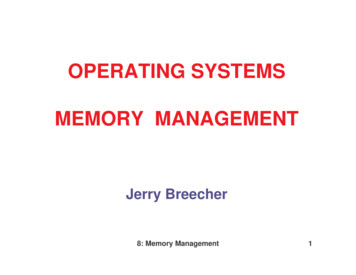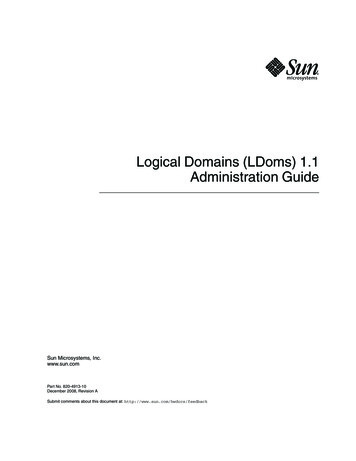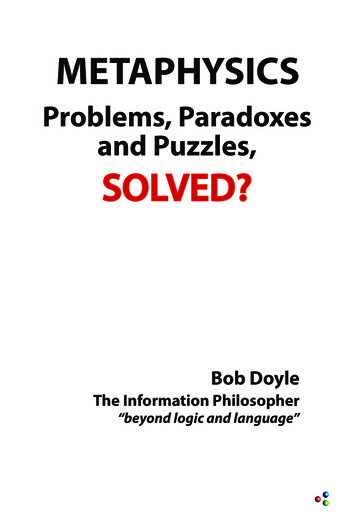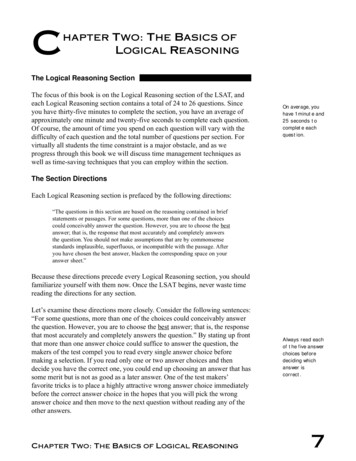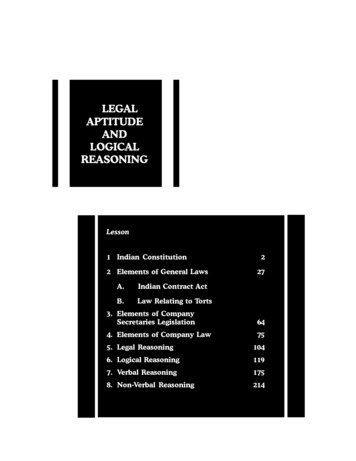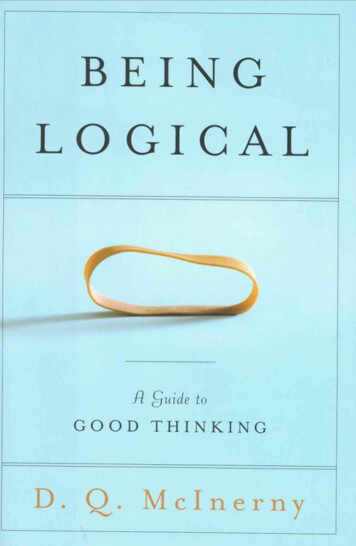
Transcription
BEINGLOGICAL
Being LogicalAGUIDEtoGOODT H I N K I N GD. Q. MclnernyRANDOMH O U S Ei MMlNEWYORK
Copyright 2004 by D. Q. MclnernyAll rights reserved under International and Pan-American CopyrightConventions. Published in the United States by Random House, animprint of The Random House Publishing Group, a division ofRandom House, Inc., New York, and simultaneously in Canada byRandom House of Canada Limited, Toronto.RANDOM HOUSE and colophon are registered trademarks ofRandom House, Inc.LIBRARY OF C O N G R E S S CATALOGING-IN-PUBLICATION DATAMclnerny, D. Q.Being logical: a guide to good thinking / D. Q. Mclnerny.p. cm.Includes bibliographical references.ISBN 1-4000-6171-71. Logic. 2. Reasoning. 3. Thought and thinking. I. Title.BC71.M37 2004160—dc222003058779Text design by Mary A. WirthPrinted in the United States of America on acid-free paperRandom House website address: www.atrandom.com9 8 7 6 5 4 3 2 1First Edition
IN MEMORIAMAUSTIN C L I F F O R D M C I N E R N YandVIVIAN G E R T R U D E R U S H M C I N E R N Y
We may take Fancy for a companion,but mustfollow Reason as our guide.— D R . SAMUEL JOHNSON
PrefaceL O G I C IS ABOUT clear and effective thinking. It is a science and an art. This book is intended to introduce readersto the rudiments of the science as well as to the basic skillsassociated with the art.We all know people who are very bright but who do notalways shine when it comes to being logical. They have theability to think logically—that is, clearly and effectively—but that ability does not habitually manifest itself. The likelihood is that it has never been properly developed,pointing to a deficiency in their education. Indeed, logic isthe very backbone of a true education, and yet it is seldomtaught as such in American schools. To my mind, logic is themissing piece of the American educational system, the subject that informs every other subject from English to historyto science and math.Some readers, especially if this book represents theirfirst serious encounter with logic, might react skittishly towhat appears to be an overly technical vocabulary, or to the1X
XPrefacesymbolic notation that logic makes frequent use of. Don'tbe scared off by initial impressions. I have made a concertedeffort to present whatever technical matters I deal with here(which in any event are not all that trying) in as simple anduncomplicated a way as possible. At the same time, however, I have tried to avoid lapsing into the simplistic. Adumbed-down logic is not logic at all. Other readers mightbe put off by what they perceive to be an emphasis upon theobvious. I do, in fact, place a good deal of stress on the obvious in this book, and that is quite deliberate. In logic, as inlife, it is the obvious that most often bears emphasizing, because it so easily escapes our notice. If I have belabored certain points, and regularly opted for the explicit over theimplicit, it is because I adhere to the time-honored pedagogic principle that it is always safest to assume as little aspossible.Logic, taken as a whole, is a wide, deep, and wonderfully varied field, and I would be pleased if my readers, as aresult of their encounter with this little book, were moved tobecome more familiar with it. However, my aim here is verymodest. This is neither a treatise in logical theory nor a textbook in logic—though I would not be disappointed to learnthat it proves useful in the classroom. My governing purpose was to write a practical guidebook, presenting the basicprinciples of logic in a way that is accessible to those who areencountering the subject for the first time. Being Logicalseeks to produce practitioners, not theoreticians—peoplefor whom knowing the principles of logic is in the service ofbeing logical.
PrefacexiIn the hope of better serving the practical ends of thebook, I have adopted a somewhat informal style, often addressing the reader directly, and, in the manner of a tutor orcoach, sometimes assuming a distinctively directive tone. Itreat logic in five stages, represented by the five parts of thebook, each successive stage building upon the one that preceded it. Part One is preparatory, and deals with the properframe of mind that must be established if logical thinking isto take place at all. In Parts Two and Three, the heart of thebook, we pass into the realm of logic proper. Part Two explains the foundational truths that govern logical thinking,while Part Three focuses on argument—the public expression of logical thinking. In Part Four, I discuss attitudes andframes of mind that promote illogical thinking. Finally, PartFive concentrates on the particulars of illogical thinking—the fallacies.A final word, of admiration and appreciation, for asparkling little book called The Elements of Style, by WilliamStrunk, Jr., and E. B. White, which was the inspiration forBeing Logical. What I have managed to accomplish here is nomatch for the unique achievement of Strunk and White, butI hope that Being Logical might to some degree succeed indoing for the cause of good thinking what The Elements ofStyle has done for that of good writing. My earnest wish isthat this book may succeed in convincing its readers of theintrinsic importance of logic—and that it engender in theman appreciation for the priceless satisfaction which inevitably accompanies the happy state of being logical.
ContentsPrefaceixPART O N E — P R E P A R I N G THE M I N D FOR L O G I C1/. Be Attentive2. Get the Facts Straight3. Ideas and the Objects of Ideas4. Be Mindful of the Origins of Ideas5. Match Ideas to Facts6. Match Words to Ideas7. Effective Communication8. Avoid Vague and Ambiguous Language9. Avoid Evasive Language10. Truth347791112161819PART T W O — T H E BASIC P R I N C I P L E S OF L O G I C1. First Principles2. Real Gray Areas, Manufactured Gray Areas3. There's an Explanation for Everything,EventuallyX11123253032
X 1 VContents4. Don V Stop Short in the Search for Causes5. Distinguish Among Causes6. Define Your Terms7. The Categorical Statement8. Generalizing3335374142PART T H R E E — A R G U M E N T : T H E LANGUAGE OF LOGIC45/. Founding an Argument2. The Move from Universal to Particular3. The Move from Particular to Universal4. Predication5. Negative Statements6. Making Comparisons7. Comparison and Argument8. Sound Argument9. Conditional Argument/ 0. Syllogistic A rgument/ / . 7 7r»M of Premises/ 2 . 7 Relevancy of Premises/ J . Statements of Fact, Statements of Value14. Argumentative Form/ 5 . Conclusions Must Reflect Quantity of Premises16. Conclusions Must Reflect Quality of Premises/ 7. Inductive Argument18. Assessing Argument/P. Constructing an Argument47495051525558596367707072731179818486PART F O U R — T H E SOURCES OF ILLOGICAL THINKING1. Skepticism2. Evasive AgnosticismJ. Cynicism and Naive Optimism /. Narrow-Mindedness8991929394
Contents5. Emotion and Argument6. The Reason for Reasoning7. Argumentation Is Not Quarreling8. The Limits of Sincerity9. Common Sensexv9596979898PART F I V E — T H E PRINCIPAL FORMS OFILLOGICAL THINKING101/. Denying the Antecedent2. Affirming the Consequent3. The Undistributed Middle Term4. Equivocation5. Begging the Question6. False Assumptions7. The Straw-Man Fallacy ?. /.f/'/7g and Abusing TraditionP. Two Wrongs Don V J/tfi a Right/#. 7 Democratic Fallacy/ / . 7 ? Ad Hominem Fallacy/ ?. Substituting for the Force of Reason1 3 . The Uses and Abuses of Expertise14. The Quantifying of Quality15. Consider More Than the Source16. Stopping Short at Analysis/ 7. Reductionism18. Misclassification/P. The Red Herring ?#. Laughter as Diversionary Tactic2 / . 7 tfrs tfj Diversionary TacticZ?. il// Inability to Disprove Does Not Prove23. The False Dilemma2 * Post Hoc Ergo Propter 012012112112212312412 5125
ContentsXV 125.26.27.28.Special PleadingThe Fallacy of ExpediencyAvoiding ConclusionsSimplistic ReasoningAfterword12 7127128128131
PARTONEPreparing the Mindfor Logic
Being logical presupposes our having a sensitivity to language and a knack for its effective use, for logic andlanguage are inseparable. It also presupposes our having ahealthy respect for the firm factualness of the world inwhich we live, for logic is about reality. Finally, being logicalpresupposes a lively awareness of how the facts that are ourideas relate to the facts that are the objects in the world, forlogic is about truth. In this first part of the book I will discuss those attitudes, points of view, and practical procedureswhose adoption prepares the mind for a successful engagement with logic./. Be AttentiveMany mistakes in reasoning are explained by the fact thatwe are not paying sufficient attention to the situation inwhich we find ourselves. This is especially true in familiarsituations. That very familiarity causes us to make carelessjudgments about facts right before our eyes. We misread asituation because we are skimming it, when what we shouldbe doing is perusing it. Often, we assume that a familiar situation will be but a repeat performance of a similar situationwe've experienced before. But, in the strictest sense, thereare no repeat performances. Every situation is unique, andwe must be alert to its uniqueness.The phrase "to pay attention" is telling. It reminds us3
4Being Logicalthat attention costs something. Attention demands an active, energetic response to every situation, to the persons,places, and things that make up the situation. It is impossible to be truly attentive and passive at the same time. Don'tjust look, see. Don't just hear, listen. Train yourself to focuson details. The little things are not to be ignored, for it isjust the little things that lead us to the big things.2. Get the Facts StraightA fact is something made or done. It has clear objective status. It is something we respond to as having an independentstatus all its own. It is naggingly persistent, demands recognition, and can be nasty if ignored.There are two basic types of objective facts, things andevents. A "thing" is an actually existing entity, animal, vegetable, or mineral. The White House is an example of thefirst type of fact, and the assassination of Abraham Lincolnof the second. The first type is more basic than the secondbecause events are made up of things or of the actions ofthings. A state dinner is to be held at the White House. Suchan event could not take place were it not for the existence,first and foremost, of the fact that is the White House, andcountless other facts as well. In order to establish the factualness of an event, any number of concrete things need tobe appealed to.To determine the reality of a fact that is a thing, all youneed do is pay it a visit. If it actually exists it must be somewhere, and, assuming its place to be accessible to you,you can verify its factualness by direct observation. Take the
Preparing the Mind for Logic5case of the White House. To ascertain its being a fact, ratherthan purely imaginary, you can travel to Washington, D.C.,and there see the White House with your own eyes. That isthe most direct and reliable way to establish its factualness.But you could also rely on indirect evidence: For example,by taking the word of a trustworthy eyewitness that theWhite House is indeed in Washington, D.C. Or you coulddecide that photographic evidence is sufficient to establishfactualness.But what about an event like Lincoln's assassination?We say that is a fact. What is the justification for that claim?It is an event that is over and done with, and there are no living witnesses to the event whom we might consult. Obviously, we did not ourselves witness the event, so directevidence is out of the question. In this case our approachwill be to acquaint ourselves with a variety of things thatserve as indirect evidence of the event. For example, wewould consult official documents (police reports, the deathcertificate, etc.), newspaper accounts, photographs, memoirs, diaries, and items in the Congressional Record, all ofwhich are facts in their own right and whose only reasonableexplanation is the factualness of Lincoln's assassination. Onthe basis of the factualness of these things, we establish thefactualness of the event. And we thus establish a historicalfact.Facts can also be thought of as objective or subjective.Both things and events are objective facts. They exist in thepublic domain and are in principle accessible to all. A subjective fact is one that is limited to the subject experiencingit. A headache would be an example of a subjective fact. If I
6Being Logicalam the one experiencing the headache, then I have directevidence of its factualness. But if it is you experiencing theheadache, I can establish its factualness only indirectly. Imust take your word that you have a headache. Establishingthe reality of subjective facts depends entirely on the trustworthiness of those who claim to be experiencing them.To sum up how we get the facts straight: If a given factis an actually existing thing to which we have access, thenthe surest way to establish its factualness is to put ourselvesin its presence. We then have direct evidence of it. If wecannot establish factualness by direct evidence, we mustrigorously test the authenticity and reliability of whateverindirect evidence we rely upon so that, on the basis of thatevidence, we can confidently establish the factualness ofthe thing.There are only a very limited number of significantpublic events which we can experience directly. This meansthat, in almost every case, we must rely on indirect evidence. In establishing the factualness of events by indirectevidence, we must exercise the same kind of care we do inestablishing the factualness of "things" by indirect evidence. It all comes down to the authenticity and reliabilityof our sources.A subjective fact, to the subject experiencing it, is selfevident under normal circumstance. However, through suchmechanisms as self-delusion or rationalization, a personcould fail to get straight a fact even about himself.Because the establishment of the factualness of a subjective fact pertaining to another person depends entirelyon the trustworthiness of that person, you must first, insofar
Preparing the Mind for Logic7as it is possible, establish the trustworthiness of the personin question.3. Ideas and the Objects of IdeasEvery idea in the mind is ultimately traceable to a thing, orthings, actually existing in a world that is independent ofand apart from the mind. An idea is the subjective evocationof an objective fact. Clear ideas, then, are ideas that faithfully reflect the objective order from which they derive. Unclear ideas, conversely, are those that give us a distortedrepresentation of the objective world.Though the control we have over our ideas is not absolute, it is real. This means that we are not helpless in theface of unclear ideas. To ensure that our ideas are clear, wemust vigilantly attend to the relationship between anygiven idea and its object. If it is a strained relationship, if theconnection between the idea and its object is tenuous, thenwe are dealing with an unclear idea.It is wrong to suppose that because we know things inthe world only through our ideas, it is only our ideas whichwe really know. Our ideas are the means, not the ends, of ourknowledge. They link us to the world. If they are clear ideas,the links are strong. The most efficient way to clarify ourideas is to look through them to the objects they represent.4, Be Mindful of the Origins of IdeasWe all tend to favor our own ideas, which is natural enough.They are, after all, in a sense our very own babies, the con-
8Being Logicalceptions of our minds. But conception is possible in thethinking subject only because of the subject's encounterwith the world. Our ideas owe their existence, ultimately, tothings outside and independent of the mind, to which theyrefer: objective facts.Our ideas are clear, and our understanding of them isclear, only to the extent that we keep constant tabs on thethings to which they refer. The focus must always be on theoriginating sources of our ideas in the objective world. Wedo not really understand our own ideas if we suppose themto be self-generating, that is, not owing their existence toextramental realities.The more we focus on our ideas in a way that systematically ignores their objective origins, the more unreliablethose ideas become. The healthy bonds that bind togetherthe subjective and objective orders are put under greatstrain, and if we push the process too far, the bonds maybreak. Then we have effectively divorced ourselves fromthe objective world. Instead of seeing the world as it is, wesee a projected world, one that is not presented to our mindsbut which is the product of our minds.When we speak of "establishing a fact," we do not referto establishing the existence of an idea in the mind. Theidea in the mind, as we have seen, is a subjective fact, butthe kind of fact we are concerned with establishing is an objective fact. To do so, we must look beyond our ideas totheir sources in the objective world. I establish a fact if I successfully ascertain that there is, for a particular idea I have inmind, a corresponding reality external to my mind. For instance, I have a particular idea in my mind, which I label
Preparing the Mind for Logic9"cat." Corresponding to that idea are actually existingthings in the extramental world called "cats." But I couldhave another idea in my mind, which I label "centaur" butfor which no corresponding fact can be found in the extramental world. For all that, the idea of "centaur" is a subjective fact, since it really exists as an idea in my mind.5. Match Ideas to FactsThere are three basic components to human knowledge:first, an objective fact (e.g., a cat); second, the idea of a cat;third, the word we apply to the idea, allowing us to communicate it to others (e.g., in English, "cat"). It all starts withthe cat. If there were no real cats, there would be no ideaabout them, and there would be no word for the idea. I havebeen stressing the general point that ideas (subjective realities) are clear or sound to the extent that they reflect objective realities. And we have said that all ideas have theirultimate source in the objective world. Now we must lookmore closely at how ideas relate to the objective world, forthe relation is not always simple. Next, we must address thequestion: How are bad ideas possible?Sometimes there is a direct correlation between an ideaand an objective fact. Example: the idea of cat. We will callthis a "simple" idea. Corresponding to my idea of cat is asingle, particular sort of entity in the extramental world—that furry, purring creature which in English we name a cat.In dealing with simple ideas it is relatively easy to test theirreliability, because we need only refer to one thing. My ideaof cat is clear and sound if it refers to an actual cat.
10Being LogicalWe will call "complex" ideas those for which there is nosimple one-to-one correspondence between idea and thing.Here the correspondence is one to many. There is morethan a single originating source for this kind of idea in theobjective world. Let's take the idea of democracy. Is it aclear or a sound one? It is, at least potentially. It is a clear orsound idea to the extent that we are able to relate it to theobjective world. But there are many things in the objectiveworld that go together to compose the rich meaning of theidea of democracy: persons, events, constitutions, legislativeacts, past institutions, present institutions. If my idea ofdemocracy is going to be communicable to others, it mustrefer to what is common to me and to others, those manythings in the objective world that are its originating source.To prevent my idea from being a product of pure subjectivism, in which case it could not be communicated to others, I must continuously touch base with those many facts inthe objective world from which the idea was born.How are we to explain bad (that is, unclear or unsound)ideas? An idea is unclear or unsound to the degree that it isdistanced from and unmindful of its originating source inthe objective world. No idea, even the most bizarre, cancompletely sever its ties with the objective world, but ideascan become so remote from that world that their relation toit is difficult, if not impossible, to see. Bad ideas can be informative, not about the objective world—for they haveceased faithfully to reflect that world—but about the subjective state of the persons who nourish those ideas. Badideas do not just happen. We are responsible for them. Theyresult from carelessness on our part, when we cease to pay
Preparing the Mind for Logic11sufficient attention to the relational quality of ideas, or,worse, are a product of the willful rejection of objectivefacts.6. Match Words to IdeasAs we have seen, first comes the thing, then the idea, thenthe word. If our ideas are sound to the extent that they faithfully represent the thing, they will be clearly communicableonly if we clothe them in words that accurately signify them.Ideas as such are not communicable from one mind to another. They have to be carefully fitted to words, so that thewords might communicate them faithfully. Putting the rightword to an idea is not an automatic process, and sometimesit can be quite challenging. We have all had the experienceof knowing what we want to say but not being able to comeup with the words for it.How do we ensure that our words are adequate to theideas they seek to convey? The process is essentially thesame as the one we follow when confirming the clarity andsoundness of our ideas: We must go back to the sources ofthe ideas. Often we cannot come up with the right word foran idea because we don't have afirmgrasp on the idea itself.Usually, when we clarify the idea by checking it against itssource in the objective world, the right word will come to us.Sometimes there is a perfect match between word andidea, which would mean a perfect match between wordand thing, for if the idea is clear it faithfully represents thething, and if the word accurately expresses the idea, itwould at the same time faithfully identify the thing. This
12Being Logicalcommonly happens with simple ideas. If I say, "The monument is granite," and the monument to which I refer is infact granite, then in "granite" I have the perfect match forthe idea and the thing it represents. It gets more complicated when we are dealing with complex ideas, but the general principle remains the same: In order to guaranteeaccuracy in your use of words, go back to the objective factsthat are the foundational explanations for words.In the effort to come up with words that accurately convey ideas, our ultimate purpose should always be this: to soshape our language that it communicates to others the waythings actually are—objective reality. It is not enough thatlanguage be satisfied with ideas as such, but with clear andsound ideas. Let us say I fervently hold to the real existenceof Lilliput, and have all sorts of ideas about it. I may be ableto come up with scads of words that accurately convey thoseideas to you, but all those words do is reveal the state of mymind. They do not reveal the state of the world. They dealwith subjective reality, not objective reality.7. Effective CommunicationLanguage and logic are inextricably bound up with eachother. How that is so becomes clear when we recall the relationship between the idea and the word. Although it is a disputed point among the experts, it seems possible that wecan hold an idea in our mind without having a precise wordfor it. In any event, if we are going to attempt to communicate an idea to others, it is imperative that we express it by aword. And, as we have seen, the better the fit between word
Preparing the Mind for Logic13and idea, the clearer and more effective the communicationof the idea.Matching words to ideas is the first and most basic stepin communication. The next step is putting ideas togetherto form coherent statements. If I said to you "dog" or "cat,"your response would be expectant, waiting to hear more.You would wonder, What about dogs or cats? Through thewords I'm speaking, you know the ideas I'm dealing with,but you don't know what I intend to do with those ideas.I'm simply "saying" the ideas; I'm not saying anything aboutthem. We say something about ideas when we put them together to form statements that can be responded to affirmatively or negatively. Notice that if someone simply says"dog," there would not be much sense in responding with"That's true" or "That's false." But if someone says something about a dog—"The dog is in the garage"—then such aresponse would be appropriate. "Statement" has a specialmeaning in logic. It is a linguistic expression to which theresponse of either "true" or "false" is appropriate.Words have been called the building blocks of language,but it is the statement that logic starts with, for it is only at thelevel of the statement that the question of truth or falsity isintroduced, and logic is all about establishing what is trueand distinguishing it from what is false. It can sometimes betough enough determining whether a statement is true orfalse when that statement is clearly understood. But if wehave difficulty understanding what a statement is attempting to say, then our difficulties are compounded, because wehave to figure out the meaning of the statement before wecan get on to the main business of determining whether it is
14Being Logicaltrue or false. Thus the importance of clear, effective communication.It is impossible to have clear communication withoutclear thinking. How can I give you a clear idea of somethingif it is not first clear in my own mind? However, clear ideasdo not guarantee clear communication. I may have a perfectly good idea of what I'm trying to say, but can't succeedin getting my ideas across clearly and effectively.Here are some basic guidelines for effective communication:Don't assume your audience understands your meaning if youdon't make it explicit.The more complicated the subject matter dealt with,the more important this point is. We sometimes take it forgranted that an audience is aware of background information that is necessary for a correct understanding of the subject we're speaking on, but in fact the audience may bequite innocent of this information. When in doubt, spellout the background information. It is always better to err onthe side of saying too much than on the side of saying toolittle.Speak in complete sentences.The sentence with which logic is most concerned is thedeclarative sentence. A declarative sentence is the samething as a statement (also called a "proposition" in logic). IfI say "Dog turtle," "Falling stock prices in July," "Thebuilding's Indiana limestone facade," you could presume Iam intending in each case to link certain ideas together, but
Preparing the Mind for Logic15you do not know how. That is because I am not forminggenuine statements. I need to speak in complete sentences:"The dog bit the turtle," "Falling stock prices in July depressed Julian," "The building's Indiana limestone facadewas severely defaced by the vandals."Don't treat evaluative statements as if they were statements ofobjective fact."The Pearce Building is on the corner of Main andAdams" is a statement of objective fact, and as such it is eithertrue or false. "The Pearce Building is ugly" is an evaluativestatement, and as such it combines both subjective and objective elements. Evaluative statements do not lend themselves to a simple true-or-false response. We must not inviteunwarranted responses to statements, which is just what wedo when we attempt to pass off an evaluative statement as ifit were a statement of objective fact. True statements of objective fact are not open to argument; evaluative statementsare. If I want an evaluative statement to be accepted, I mustargue for it.Avoid double negatives.In Spanish, double negatives have the effect of intensifying the negative import of a sentence. In English, doublenegatives cancel each other out, making the sentence affirmative. This can sometimes cause confusion, since the sentence sounds negative but is in fact affirmative. To avoidthat confusion, and for greater clarity of expression, avoiddouble negatives. Instead of saying, "It is not unlikely thatshe would be welcome," say "She would be welcome."
16Being LogicalGear your language to your audience.If you are a physicist discussing the principle of indeterminacy with other physicists at a professional conference,you can freely use the technical jargon of your profession.But if you are asked to explain that principle to a group ofnonphysicists, you should adjust your vocabulary and present your material in ordinary language. Don't use technicalor "insider" language merely to impress people. The pointis to communicate. The two extremes to be avoided aretalking down to people and talking over their heads.An important point to note here is that we obviouslycannot attune our language to our audience if we do notknow our audience. The first order of business, then, is tohave a reasonably good sense of the composition and background of the group you will be addressing.8. Avoid Vague and Ambiguous LanguageVagueness and ambiguity are specific instances of the kindof language that can inhibit clear and effective communication. The word "vague" comes from the Latin adjectivevagus, which means "wandering," while the word "ambiguous" traces its origin to the Latin verb ambigere, whichmeans "to wander about." Vague and ambiguous words andexpressions wander about among various ideas instead ofsettling definitely upon one or another particular idea. Theyall share the defect of not having a fixed, unmistakablemeaning.A word is vague if its referent is blur
Being logical: a guide to good thinking / D. Q. Mclnerny. p. cm. Includes bibliographical references. ISBN 1-4000-6171-7 1. Logic 2. Reasoning. 3. Thought and thinking. I. Title. BC71.M37 2004 160—dc22 2003058779 Text design by Mary A. Wirth Printed in the United States of America on acid-free paper Random House websit addresse www.atrandom .File Size: 2MB



